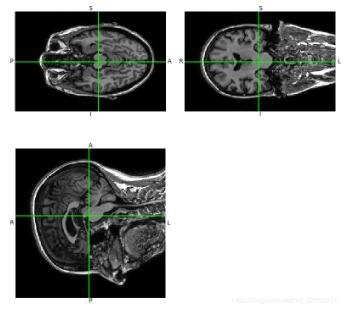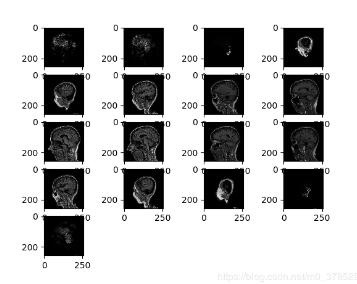Python reads .nii format image examples
I won’t say much nonsense, everyone should just look at the code~
# encoding=utf8
'''
View and display nii files
'''
import matplotlib
matplotlib.use('TkAgg')from matplotlib import pylab as plt
import nibabel as nib
from nibabel import nifti1
from nibabel.viewers import OrthoSlicer3D
example_filename ='../ADNI_nii/ADNI_002_S_0413_MR_MPR____N3__Scaled_2_Br_20081001114937668_S14782_I118675.nii'
img = nib.load(example_filename)print(img)print(img.header['db_name']) #Output header information
width,height,queue=img.dataobj.shape
OrthoSlicer3D(img.dataobj).show()
num =1for i inrange(0,queue,10):
img_arr = img.dataobj[:,:,i]
plt.subplot(5,4,num)
plt.imshow(img_arr,cmap='gray')
num +=1
plt.show()
3 D shows the result:

ADNI data dimensions (256, 256, 170) segment display:

Supplementary knowledge: python nii image expansion
I won’t say much nonsense, everyone should just look at the code~
import os
import nibabel as nib
import numpy as np
import math
src_us_folder ='F:/src/ori'
src_seg_folder ='G:/src/seg'
aug_us_folder ='G:/aug/ori'
aug_seg_folder ='G:/aug/seg'
img_n=10
rotate_theta = np.array([0, math.pi/2])
# augmentation
aug_cnt =0for k inrange(img_n):
src_us_file = os.path.join(src_us_folder,(str(k)+'.nii'))
src_seg_file = os.path.join(src_seg_folder,(str(k)+'_seg.nii'))
# load .nii files
src_us_vol = nib.load(src_us_file)
src_seg_vol = nib.load(src_seg_file)
# volume data
us_vol_data = src_us_vol.get_data()
us_vol_data =(np.array(us_vol_data)).astype('uint8')
seg_vol_data = src_seg_vol.get_data()
seg_vol_data =(np.array(seg_vol_data)).astype('uint8')
# get refer affine matrix
ref_affine = src_us_vol.affine
############### flip volume ###############
flip_us_vol = np.fliplr(us_vol_data)
flip_seg_vol = np.fliplr(seg_vol_data)
# construct newvolumes
new_us_vol = nib.Nifti1Image(flip_us_vol, ref_affine)
new_seg_vol = nib.Nifti1Image(flip_seg_vol, ref_affine)
# save
aug_us_file = os.path.join(aug_us_folder,(str(aug_cnt)+'.nii'))
aug_seg_file = os.path.join(aug_seg_folder,(str(aug_cnt)+'_seg.nii'))
nib.save(new_us_vol, aug_us_file)
nib.save(new_seg_vol, aug_seg_file)
aug_cnt = aug_cnt +1
############### rotate volume ###############
for t inrange(len(rotate_theta)):
print 'rotating %d theta of %d volume...'%(t, k)
cos_gamma = np.cos(t)
sin_gamma = np.sin(t)
rot_affine = np.array([[1,0,0,0],[0, cos_gamma,-sin_gamma,0],[0, sin_gamma, cos_gamma,0],[0,0,0,1]])
new_affine = rot_affine.dot(ref_affine)
# construct newvolumes
new_us_vol = nib.Nifti1Image(us_vol_data, new_affine)
new_seg_vol = nib.Nifti1Image(seg_vol_data, new_affine)
# save
aug_us_file = os.path.join(aug_us_folder,(str(aug_cnt)+'.nii'))
aug_seg_file = os.path.join(aug_seg_folder,(str(aug_cnt)+'_seg.nii'))
nib.save(new_us_vol, aug_us_file)
nib.save(new_seg_vol, aug_seg_file)
aug_cnt = aug_cnt +1
The above example of reading .nii format images in python is all the content shared by the editor. I hope to give you a reference.
Recommended Posts